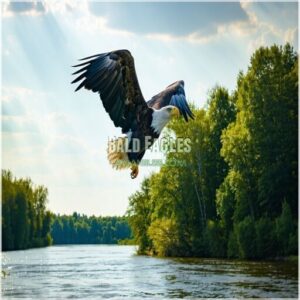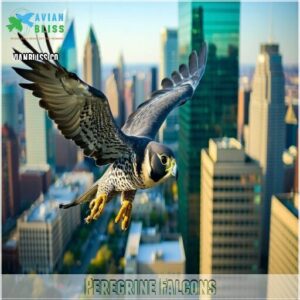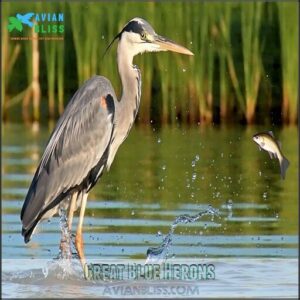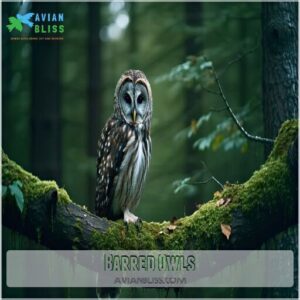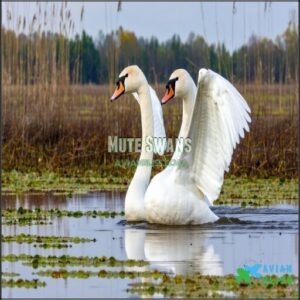This site is supported by our readers. We may earn a commission, at no cost to you, if you purchase through links.

You’ve got the bald eagle, a true symbol of power, soaring with wingspans up to seven feet.
Then there’s the great blue heron, gracefully wading through wetlands like nature’s supermodel.
Don’t forget the wild turkey—yes, they’re big and strut around like they own the place.
Catch sight of brown pelicans skimming the coast or ospreys diving like fearless sky acrobats.
Whether you’re near the mountains or the coast, these feathered giants make the Tar Heel State a birdwatcher’s paradise.
Ready to spot your next winged wonder?
Table Of Contents
- Key Takeaways
- Types of Large Birds in North Carolina
- Characteristics of Large Birds in North Carolina
- Large Birds of Prey in North Carolina
- Bird Watching in North Carolina
- Conservation Efforts for Large Birds
- Interesting Facts About Large Birds in North Carolina
- Invasive and Non-Native Birds in North Carolina
- Exploring North Carolina’s Bird Diversity
- Frequently Asked Questions (FAQs)
- Are there any big birds in North Carolina?
- What is the state bird of North Carolina?
- How many birds of prey have you seen in North Carolina?
- Which bird is the most frequently spotted in North Carolina?
- What do birds eat in North Carolina?
- Are there hummingbirds in North Carolina?
- What is the big bird in North Carolina?
- What are the 3 largest birds in North America?
- Are there osprey in NC?
- What is the largest hawk in North Carolina?
- Conclusion
Key Takeaways
- You’ll find majestic large birds like bald eagles, great blue herons, and wild turkeys across North Carolina, showcasing diverse habitats from wetlands to forests.
- Bald eagles and ospreys dominate skies with their incredible fishing and hunting skills, often seen near water bodies like coastal areas and lakes.
- Great blue herons and brown pelicans thrive in wetlands and coastal zones, using unique hunting techniques like wading or plunge-diving for fish.
- North Carolina’s bird conservation efforts have helped species like wild turkeys and bald eagles recover, ensuring these feathered giants remain a birdwatcher’s delight.
Types of Large Birds in North Carolina
You’ll spot three main categories of large birds soaring through North Carolina’s diverse landscapes: impressive birds of prey like bald eagles and red-tailed hawks, statuesque waterbirds including great blue herons and brown pelicans, and other magnificent species such as wild turkeys and sandhill cranes.
Whether you’re watching a hawk circling above mountain forests or a pelican diving into coastal waters, these winged giants will make you reach for your camera faster than you can say "bird watching bucket list" with the thrill of seeing a wild turkey.
Spotting North Carolina’s majestic birds will have you grabbing your camera before you can blink, swept away by their breathtaking beauty.
Birds of Prey in North Carolina
North Carolina’s skies serve as hunting grounds for magnificent birds of prey that’ll take your breath away.
When exploring the state’s diverse raptor habitats, you’ll witness nature’s aerial hunters in action.
Here are four impressive predators you might spot:
- Bald Eagles – These majestic national symbols patrol waterways with wingspans reaching 8 feet, snatching fish with lightning-quick precision
- Red-tailed Hawks – The most common hawks in NC, recognizable by their rusty tails as they hover above open fields scanning for prey
- Ospreys – These fishing specialists perform spectacular dives, plunging feet-first into water to grab fish
- Great Horned Owls – These night hunters silently swoop down on unsuspecting prey thanks to specialized feathers
These raptors have adapted remarkable hunting strategies including keen eyesight (they can spot prey from hundreds of feet overhead), powerful talons, and impressive diving abilities.
Their nesting behaviors and conservation status vary across species.
Large Waterbirds in North Carolina
While birds of prey dominate the skies, the waterbirds of North Carolina create equally impressive spectacles in coastal habitats throughout the state.
You’ll spot magnificent waterfowl gliding across NC’s wetlands, from pristine sounds to tranquil lakes. These large birds showcase stunning plumage variations that change with seasons and breeding cycles.
| Species | Size | Feeding Habits |
|---|---|---|
| Great Blue Heron | 4-5 feet tall | Fish, frogs, small mammals |
| Brown Pelican | 7.5 ft wingspan | Plunge-diving for fish |
| Great Egret | 3 feet tall | Shallow water stalking |
| Double-crested Cormorant | 4 ft wingspan | Underwater pursuit |
Pelicans often steal the show with their impressive bill pouches and synchronized fishing techniques. Their migratory patterns bring them to our shores seasonally, making wetland conservation essential for their survival. Next time you’re near water, look for these majestic creatures!
Other Large Birds in North Carolina
While waterbirds dazzle along shorelines, North Carolina’s inland areas host equally impressive avian giants.
You’ll encounter a variety of large species that call the state home, including remarkable creatures like:
- Common Ravens showcasing their legendary intelligence through complex problem-solving
- Turkey Vultures demonstrating fascinating vulture ecology with their efficient cleanup services
- Snow Geese creating spectacular displays during seasonal geese migration
- Tundra Swans exhibiting elegant swan behavior in winter habitats
Beyond the typical birds of prey, NC birds offer unforgettable wildlife encounters. Wild turkeys strut through forests with prehistoric charm, while stork habitats attract photographers year-round.
Whether you’re hiking mountain trails or exploring piedmont woodlands, these large birds offer a glimpse into their natural habitats and provide opportunities to observe their unique behaviors, making North Carolina a great destination for birdwatching and wildlife exploration.
Characteristics of Large Birds in North Carolina
You’ll notice North Carolina’s large birds showcase impressive physical traits, from the bald eagle’s massive 8-foot wingspan to the great blue heron‘s statuesque 54-inch height.
These magnificent creatures might make you feel a bit short in comparison, but they’re well worth craning your neck for when you spot their distinctive flight patterns and unique features across the state’s diverse habitats, which is a truly magnificent sight.
Size and Weight of Large Birds
When you glimpse North Carolina’s large birds, you’ll notice impressive size and weight variations.
From the heavyweight Bald Eagle (6.5-15 lbs) to the lighter Cooper’s Hawk (just 8-24 oz), these creatures showcase remarkable sexual dimorphism.
Weight differences between males and females are common—female raptors often outweigh males!
Growth stages dramatically affect measurements too, with juveniles weighing substantially less than their adult counterparts, which is a notable aspect of raptors.
Wingspan and Flight Patterns of Large Birds
The majestic wingspan of large birds across North Carolina’s skies will leave you breathless as you witness nature’s aerodynamic marvels in action.
When you’re bird watching, you’ll notice each species has developed unique flight patterns perfectly suited to their hunting and migration needs.
- Bald Eagles: Display impressive 7-foot wingspans while effortlessly riding thermal currents with barely a wingbeat
- Ospreys: Execute dramatic "M-shaped" wing positions during their precision fishing dives
- Turkey Vultures: Rock side-to-side with distinctive V-shaped wing posture (called dihedral)
- Great Blue Herons: Beat their massive 6-foot wingspans slowly with necks tucked in classic S-curves
- Red-tailed Hawks: Circle with wings fully extended, soaring in spirals to spot prey below
You’ll quickly learn to identify these magnificent birds just by their flocking behavior and soaring techniques!
Unique Features of Large Birds
Nature’s engineering shines in the unique features of North Carolina’s largest feathered residents.
You’ll be amazed by the turkey vulture’s ultraviolet vision that spots hidden meals from incredible heights. When you’re near water, watch for ospreys with their specialized reversible outer toes—perfect for gripping slippery fish.
The great horned owl‘s enormous eyes (larger than its brain!) give it nighttime hunting superpowers, while its specialized plumage variation allows silent flight. Each bird’s beak tells its feeding story: the bald eagle’s razor-sharp hook for tearing, the pelican’s expandable pouch for scooping.
From distinctive vocalizations to fascinating social behavior and elaborate nesting habits, these adaptations aren’t just functional—they’re what make watching North Carolina birds such an unforgettable experience.
Large Birds of Prey in North Carolina
You’ll be amazed at North Carolina’s impressive raptors, from the majestic Bald Eagle with its 8-foot wingspan to the stealthy Great Horned Owl that hunts under cover of darkness.
Whether you’re watching Red-tailed Hawks soaring above open fields or spotting an Osprey plunging into water for fish, these aerial predators will have you reaching for your binoculars faster than you can say "talons and beaks.
Red-tailed Hawks
After learning about the physical traits of our large feathered residents, let’s meet one of North Carolina’s most recognizable raptors.
You’ll spot Red-tailed Hawks perched on highway poles or soaring above open fields throughout the state.
These impressive birds of prey showcase stunning plumage variations, with the Eastern morph displaying that classic rusty tail.
Urban Hawks have adapted well, building stick nests in tall trees across both rural and developed areas.
Their hunting techniques are remarkable—they’ll patiently watch from high perches before swooping down on unsuspecting mice or rabbits.
Thanks to protective laws, their conservation status remains strong across North Carolina, which is a result of successful conservation status efforts.
Bald Eagles
While red-tailed hawks rule open country, Bald Eagles reign over North Carolina’s waterways.
These magnificent birds of prey almost vanished from our state, but their conservation status has improved dramatically since the 1980s.
You’ll find them near Jordan Lake and Lake Mattamuskeet, where their preferred eagle habitat includes tall trees overlooking water.
With wingspans reaching 8 feet, these North Carolina giants build massive nests they’ll use for decades.
Their eagle diet consists mainly of fish, which they spot from incredible heights with vision 8 times sharper than yours!
- Can spot a fish from over a mile away with their eagle-eye vision
- Mate for life and share parenting duties equally
- Can reach speeds of 100 mph when diving for prey
- Have three eyelids to protect their eyes during flight
Bird watching tip: Look for that distinctive white head against blue sky!
Osprey
While bald eagles command attention with their iconic white heads, ospreys might be North Carolina’s most recognizable fishing specialists. You’ll spot these striking birds near lakes, rivers, and along the coast, where they’ve made a remarkable comeback thanks to conservation efforts.
With their distinctive M-shaped wings spanning up to 6 feet and white undersides contrasting with dark brown upperparts, ospreys are bird watching favorites. They’re unique among raptors for their spectacular fishing techniques—plunging feet-first into water to snatch prey with specialized, spiny feet.
Their impressive nesting habits include returning to the same massive stick nests year after year. North Carolina’s Outer Banks and Catawba River offer prime opportunities to witness these remarkable birds in action.
Great Horned Owls
Perched atop woodland canopies across North Carolina, the Great Horned Owl reigns as the state’s largest owl species.
With impressive 60-inch wingspans and distinctive ear tufts, these nocturnal hunters silently patrol our forests and suburbs alike.
You’ll find these large birds in all 100 NC counties, often roosting in tall pines near wetlands during daylight hours.
Listen for their deep "hoo-hoo" calls at dusk, especially during peak courtship season from October through December.
These raptors don’t build their own homes—they’ll commandeer nests from hawks or crows 40-70 feet high.
Their keen auditory sense helps them locate prey with exceptional accuracy.
While studying owl pellets beneath roosts, remember these magnificent birds enjoy full legal protection in North Carolina, reflecting their important conservation status.
Peregrine Falcons
While great horned owls rule the night, peregrine falcons dominate the daytime skies of North Carolina.
These sleek raptors are true speed demons, diving at an astonishing 200+ mph when hunting – the fastest creatures on Earth! With only 10-12 nesting pairs in the state, these endangered birds have made a remarkable comeback through conservation efforts.
You’ll find them perched on mountain cliffs in western NC or even on urban skyscrapers, where they’ve adapted surprisingly well.
- Falcon Fact: Peregrine falcons can spot prey from nearly a mile away – that’s like you seeing a quarter from across 10 football fields!
Want to see one? Dawn and dusk offer your best chances.
Canada Geese
Despite their classification in the outline, Canada Geese aren’t prey birds at all.
You’ll spot these iconic North Carolina residents by their black necks, white cheek patches, and unmistakable "honk."
They’re social creatures with fascinating migration patterns, though many stay year-round.
Their diet includes grasses and grains, impacting local ecosystems.
When they take flight in V-formations, it’s nature’s ballet—a must-see for birdwatching enthusiasts.
Great Blue Herons
While Canada geese rule the skies, Great Blue Herons reign over North Carolina’s wetlands.
Standing nearly 4 feet tall with a wingspan reaching 7 feet, these majestic blue-gray giants are North Carolina’s most recognizable wading birds.
Their patient hunting style is fascinating to watch:
- They’ll stand motionless in shallow water, yellow eyes locked on prey
- When fish or frogs appear, they strike with lightning speed
- After feeding, they’ll spread those magnificent wings and glide effortlessly between Heron Habitats
Look for their impressive stick nests in treetop colonies, especially in the Coastal Plain where Heron Conservation efforts have helped populations thrive since 1980.
Double-crested Cormorants
While Great Blue Herons wade elegantly through shallow waters, their dark aquatic cousins take a more dramatic approach to fishing.
Double-crested Cormorants are underwater specialists you’ll find throughout North Carolina’s coastal habitats and inland lakes. These sleek black birds with hooked bills are master divers, plunging up to 25 feet beneath the surface in pursuit of fish. Their partially waterproof feathers serve a clever purpose – they provide just enough buoyancy while allowing them to sink when hunting.
You’ll often spot these large birds in their signature pose: perched with wings spread wide to dry after a fishing expedition.
- Winter flocks create impressive spectacles, with coastal areas hosting thousands during migration seasons
- Their cormorant diet consists primarily of fish, which they catch using remarkable diving behavior
- Flock dynamics change seasonally, with highest concentrations in Pamlico and Core Sounds from mid-November through mid-December
Brown Pelicans
While cormorants dive sleekly beneath the waves, Brown Pelicans perform spectacular aerial plunges along North Carolina’s coasts.
You’ll see these magnificent birds scooping fish with their expandable pouches in estuarine waters year-round, with populations thriving since rebounding from DDT threats.
| Feature | Description | Conservation Note |
|---|---|---|
| Plumage | Gray-brown body, yellowish head | Indicator of health |
| Habitat | Coastal islands, sandbars | Protected nesting sites |
| Population | 4,000-5,000 nesting pairs | Remarkable recovery story |
The Brown Pelicans are a notable example of conservation success, with their numbers significantly increasing after facing severe decline due to pesticide poisoning.
Wild Turkeys
The Wild Turkey stands as North Carolina’s woodland royalty, with a remarkable comeback story from near extinction to thriving in all 100 counties.
Their Turkey Behavior showcases surprising intelligence and adaptability in various bird habitats.
When exploring North Carolina’s forests, you’ll discover these magnificent birds:
- Males (toms) weigh up to 24 pounds with iridescent feathers that shimmer in sunlight
- Their Turkey Diet includes nuts, berries, insects, and seeds found while scratching through forest floors
- Despite their bulk, they can fly up to 55 mph for short distances and even swim when necessary
- Turkey Conservation efforts increased their population from just 2,000 in 1970 to over 270,000 today
- They prefer Turkey Habitat with mixed forests and open areas, roosting in trees at night for protection
You’ll often spot them strutting during spring mating season, displaying their magnificent tail fans like woodland peacocks.
Sustainable land use has also contributed to population restoration efforts.
American Crows
Unlike the gobbling wild turkeys we just discussed, American Crows bring brainpower to North Carolina’s skies. These jet-black corvids measure 16-20 inches tall with wingspans reaching 39 inches, making them substantial birds you’ll spot almost everywhere.
American Crow intelligence is off the charts! You’ll marvel watching these clever birds use sticks as tools to fish out tasty treats from tight spots. Their crow communication system includes over 20 distinct calls that warn of predators or announce food discoveries.
Their crow habitat spans from city parks to remote forests, adapting their crow diet to whatever’s available—insects, fruits, small animals, or even your picnic leftovers!
- Family-focused bird behavior: young crows help raise siblings for up to five years
- Remarkable problem-solving abilities: can remember human faces for years
- Complex crow social structure with multi-generational family groups
- Seasonal gatherings form massive roosts containing thousands of birds
You’ll never see North Carolina’s black tricksters the same way again, thanks to their complex social structure and remarkable adaptability!
Pileated Woodpeckers
Soaring through mature forests of North Carolina, the crow-sized Pileated Woodpecker is a showstopper with its flaming red crest and striking black-and-white patterns.
You’ll spot these birds by their distinctive rectangular holes carved while hunting their favorite meal—carpenter ants.
Their powerful "wuk-wuk-wuk" calls and rhythmic drumming communication echo through woodlands, announcing their presence.
Their nesting habits in old trees create essential habitat for countless forest creatures.
With a wingspan reaching 30 inches, these stunning bird species have thankfully maintained stable conservation status, making bird watching trips in NC’s woodlands truly unforgettable!
Barred Owls
The night woods come alive with the famous "who-cooks-for-you" calls of Barred Owls across North Carolina.
These round-faced hunters with soulful dark eyes are masters of silent flight, gliding effortlessly through forests from coastal swamps to mountain woodlands.
Their Barred Owl diet includes everything from mice and rabbits to frogs and crayfish, making them versatile predators in their habitat preference of mature forests with dense canopies.
- You’ll often hear these large birds before seeing them, as their distinctive vocalizations carry impressively through the trees.
- They’re year-round residents with stable conservation status in North Carolina.
- Unlike most owls, Barred Owls occasionally hunt during daylight, especially on cloudy days.
Bird Watching in North Carolina
You’ll find North Carolina’s skies and wetlands teeming with impressive avian species, from the majestic Bald Eagle with its 8-foot wingspan to the patient Great Blue Heron stalking the shallows.
Grab your binoculars and head out during migration seasons (spring and fall) when these feathered giants are most active.
Don’t forget to check out popular spots like Lake Mattamuskeet where thousands of waterfowl gather like they’re attending their own family reunion, making it a great spot to see the Great Blue Heron in its natural habitat.
Where to Find Large Birds in North Carolina
After exploring the fascinating raptors that call North Carolina home, let’s check out where you can actually find these magnificent birds!
North Carolina offers incredible birdwatching locations across its diverse landscapes:
- Coastal Hotspots: Visit Pea Island National Wildlife Refuge to spot Brown Pelicans and Bald Eagles swooping along the shoreline.
- Mountain Habitats: The Blue Ridge Parkway provides perfect perches for Red-tailed Hawks.
- Piedmont Regions: Jordan Lake hosts impressive Osprey populations.
- Refuge Locations: Alligator River’s "Wildlife Drive" offers prime viewing of Barred Owls.
Bird diversity in North Carolina peaks near wetlands—you’ll feel like you’ve hit the jackpot when an eagle soars overhead! Enthusiasts can find birding product resources to enhance their experience.
When is The Best Time to See Large Birds
Now that you’ve discovered where to spot these majestic birds, let’s talk about when you’ll have the best luck finding them!
Timing is everything in North Carolina birdwatching. Here’s when to catch our largest feathered residents:
| Season | Best Birds | Where to Look |
|---|---|---|
| Spring (Mar-May) | Osprey, hawks returning | Lakes, coastal areas |
| Summer (Jun-Aug) | Nesting eagles, herons | Rivers, wetlands |
| Fall (Sep-Nov) | Migrating raptors | Mountain ridges |
| Winter (Dec-Feb) | Waterfowl, swans | Coastal refuges |
You’ll want to head out at dawn when large birds are most active hunting breakfast. Consider purchasing Raptor migration NC products for your birdwatching needs. Weather matters too—after storms often brings unusual species driven by changing food sources and habitat availability across North Carolina.
Tips for Bird Watching in North Carolina
Now that you know when to spot North Carolina’s magnificent birds, here’s your bird watching toolkit:
- Grab Binoculars Needed – Start with 8×42 models for the perfect view, plus don’t forget Field Guides and Merlin Bird ID app for quick bird identification.
- Learn Bird Language – Master calls before you spot them; your future self will thank you!
- Follow Ethical Birding – Keep distance, minimize noise, and practice proper Habitat Respect.
- Dress Smart – Check Weather Considerations, wear neutral colors, and never underestimate comfy shoes.
To enhance your viewing experience, consider quality birding optics.
These birdwatching tips transform your North Carolina adventures!
Conservation Efforts for Large Birds
You might be surprised to learn how much work goes into keeping our largest feathered friends safe and thriving across North Carolina.
From protecting essential wetland habitats to teaching folks like you how to be better bird neighbors, conservation teams work tirelessly to guarantee these magnificent creatures stick around for future generations.
And trust me, you’ll want to get involved in the efforts to ensure these magnificent creatures continue to thrive, which is why conservation teams are so dedicated to their conservation work.
Protecting Habitats and Ecosystems
Protecting North Carolina’s large birds starts with safeguarding their homes.
You’ll find dedicated conservation teams building osprey platforms along waterways and establishing wetland conservation zones where pelicans and herons thrive.
The Outer Banks showcases successful habitat restoration projects that help eagles, ospreys, and herons flourish.
By reducing fragmentation of forests and marshlands, we’re ensuring prey availability for raptors and maintaining critical nesting protection for threatened species.
From the mountains to the coast, North Carolina’s bird habitats get special attention through controlled burns, invasive species removal, and water quality monitoring.
These efforts support entire ecosystems – when you protect one species, you’re helping countless others.
Bird conservation isn’t just about saving individual species; it’s about preserving the natural balance that keeps our bird ecology healthy for generations.
Reducing Pollution and Climate Change
Beyond habitat protection, climate change and pollution create serious headaches for North Carolina’s birds.
You can make a difference with these simple actions:
- Reduce your carbon footprint through energy-efficient choices
- Choose reusable alternatives to keep plastics out of waterways
- Support clean energy initiatives that benefit bird conservation
Every eco-friendly decision enhances prey availability and nesting success for these birds.
By reducing greenhouse gases, you’re safeguarding migration patterns and promoting bird health across the state.
North Carolina’s bird protection efforts depend on grassroots involvement.
When you invest in sustainable practices, you’re joining a community that guarantees Red-tailed Hawks and Great Blue Herons thrive for generations.
Educating The Public About Bird Conservation
You can make a real difference for North Carolina’s large birds without a science degree.
Join Citizen Science projects like bird counts or share your sightings with neighbors during walks. Educational Programs at nature centers and wildlife refuges offer hands-on learning about Conservation Awareness.
Teach kids to identify soaring eagles or explain why wetlands matter – every conversation plants seeds for future stewards. Community Outreach events and birding festivals connect you with fellow enthusiasts.
By adopting Bird-Friendly Practices like keeping cats indoors and providing clean water, you’ll help preserve these majestic creatures. Your simple actions create ripples of change for bird conservation efforts.
These projects often involve data collection and monitoring.
Interesting Facts About Large Birds in North Carolina
You’ll be amazed by North Carolina’s avian giants that range from the bald eagle with its impressive eight-foot wingspan to the great blue heron standing over four feet tall.
Whether you’re watching an osprey plunge into water for fish or listening to a wild turkey’s distinctive gobble, these magnificent birds showcase nature’s incredible diversity in your own backyard.
The Largest Birds in North Carolina
Across North Carolina’s diverse landscapes, you’ll spot Avian Giants that’ll make you stop in your tracks.
When comparing bird size among our state’s largest feathered residents, these heavyweight champions truly stand out:
- Mute Swan – Tipping the scales at 26 pounds, these elegant white beauties glide across our waters with regal grace
- Trumpeter Swan – Weighing about 25 pounds, their impressive size matches their trumpet-like calls
- Wild Turkey – Despite their ground-dwelling habits, they’re surprisingly hefty at up to 24 pounds
- Bald Eagle – Our national symbol reaches 15 pounds with habitat needs spanning forests near water bodies
Conservation status remains essential for protecting these magnificent birds and their specialized bird adaptations.
Bald Eagles, with their impressive size, sometimes steal prey from Ospreys, but conservation efforts aid recovery.
The Fastest Birds in North Carolina
In the context of speed champions in North Carolina’s skies, the Peregrine Falcon stands unrivaled.
These raptors achieve mind-blowing falcon dive speeds of up to 240 mph during hunting, making them the fastest animals on Earth.
You’ll spot these aerial hunters around coastal cliffs and even urban skyscrapers.
Ospreys demonstrate impressive bird flight techniques too, with precision dives that splash into waters at 30 mph to catch fish.
Red-tailed hawks aren’t slouches either, reaching speeds of 120 mph during their hunting swoops.
During bird migration seasons, you’ll witness these speed demons showcase their raptor flight styles across North Carolina’s diverse landscapes.
Unique Behaviors of Large Birds
While North Carolina’s speedy birds captivate with their velocity, it’s the unique behaviors of our large birds that truly showcase their remarkable adaptations.
Watch these fascinating creatures in action and you’ll witness:
- Bald eagles performing spectacular aerial courtship displays, including mid-air talon grasping during mating rituals
- Turkey vultures spreading their wings in a "horaltic pose" to warm up and kill bacteria
- Great blue herons using patient hunting strategies, standing frozen before striking with lightning speed
- Canada geese maintaining perfect V-formations during migration patterns, reducing energy by 70%
- Complex vocalizations from ravens and crows demonstrating their surprising intelligence and social structures
These large birds have developed incredible foraging techniques that you won’t want to miss, and their ability to adapt is a key factor in their survival, making them a fascinating subject to study.
Invasive and Non-Native Birds in North Carolina
You’ll spot some feathered foreigners among North Carolina’s native birds, with species like the elegant Mute Swan making themselves at home in our local waterways.
These non-native birds might look pretty, but they’re actually changing our ecosystems faster than a heron can snatch a fish, competing with native species for food and habitat.
Mute Swans
You’ll be awestruck by the Mute Swans gliding across North Carolina’s waterways with their impressive 7-8 foot wingspans.
These elegant intruders stick out with their S-curved necks and bright orange bills topped with distinctive black knobs.
Unlike our native birds, Mute Swans pack a hefty punch at 20-30 pounds and don’t play nice with others.
Their aggressive behavior during breeding season (March-June) can drive away local species as they fiercely guard 4-5 acre territories.
These year-round residents prefer shallow freshwater habitats where they’re quite the eaters, consuming up to 8 pounds of aquatic vegetation daily.
Their impact on native ecosystems contrasts with the tundra swan’s migration, which relies on diverse habitats.
While they’re undeniably beautiful additions to our landscape, Mute Swan impact on native water ecosystems is concerning due to their competitive nature and massive appetites.
Other Non-Native Bird Species
While Mute Swans get most of the attention, you’ll find several other non-native birds have settled comfortably in North Carolina’s diverse habitats.
These feathered transplants arrived through various introduction pathways and now impact local ecosystems:
- European Starlings form impressive murmurations but outcompete native cavity-nesters for prime real estate
- House Sparrows have adapted perfectly to urban environments, nesting in every neighborhood
- Eurasian Collared-Doves continue their steady march across North Carolina’s landscape
Unlike our seasonal visitors, these permanent residents create ongoing ecological impact. Control methods vary in effectiveness, and public perception remains mixed – some folks enjoy these adaptable birds while conservationists worry about future threats to native species.
Exploring North Carolina’s Bird Diversity
You’ll find North Carolina’s skies filled with an impressive array of large birds, from majestic eagles with 8-foot wingspans to great blue herons stalking the shorelines.
Whether you’re watching a turkey vulture soaring on thermal currents or spotting an osprey plunging into water for fish, these feathered giants showcase nature’s perfect balance of beauty and survival skills.
List of Birds of Prey in North Carolina
While invasive species make headlines, our native birds of prey truly rule North Carolina’s skies.
You’ll spot these impressive hunters throughout the state:
- Red-tailed Hawks: Their rusty tails flash brilliantly as they soar above open fields
- Bald Eagles: Their majestic white heads inspire awe near our lakes and coastlines
- Ospreys: Their dramatic fishing dives showcase nature’s perfect design
- Great Horned Owls: Their haunting calls will send shivers down your spine
Other notable raptors include Cooper’s hawks, peregrine falcons, and turkey vultures.
Recent conservation efforts have strengthened raptor populations, helping these magnificent predators reclaim their rightful place in our ecosystem. Some falcons reach remarkable diving speeds, making them formidable hunters.
Other Large Bird Species in North Carolina
Beyond the fierce raptors, North Carolina’s skies and waters teem with other magnificent giants.
You’ll encounter Great Blue Herons with their snake-like necks stalking wetlands, and regal Tundra Swans during winter migrations.
Vulture ecology fascinates with their critical cleanup role, while raven behavior showcases surprising intelligence.
Don’t miss the massive Wild Turkeys with their distinctive gobbling calls strutting through forests, or majestic Wood Storks in coastal habitats.
These bird species showcase Nature’s diverse adaptations.
Frequently Asked Questions (FAQs)
Are there any big birds in North Carolina?
North Carolina’s skies and wetlands are full of big birds like bald eagles, great blue herons, and ospreys.
These majestic creatures, with huge wingspans, show off nature’s power and beauty every day.
What is the state bird of North Carolina?
Picture a flash of vibrant red swaying on a dogwood branch—that’s the Northern Cardinal.
North Carolina’s state bird, this feisty little beauty sings cheerfully year-round and brightens your backyard with its bold, fiery charm!
How many birds of prey have you seen in North Carolina?
You’ve probably spotted several.
From the Great Horned Owl’s eerie stares to the Red-tailed Hawk’s soaring dives, North Carolina’s skies are a raptor lover’s dream.
Each encounter leaves you feeling amazed and connected.
Which bird is the most frequently spotted in North Carolina?
It’s like spotting a familiar face at a crowded party—Ospreys are the most frequently seen in North Carolina.
Their signature “M”-shaped flight, bold dark stripes, and fish-diving stunts make them unforgettable.
What do birds eat in North Carolina?
Birds in North Carolina enjoy a buffet of insects, seeds, fruits, nuts, small mammals, fish, and even roadkill.
Backyard feeders bring a mix of suet, sunflower seeds, and mealworms.
They’re nature’s opportunistic diners!
Are there hummingbirds in North Carolina?
In North Carolina, hummingbirds are like tiny, glittering jewels fluttering through your garden.
The ruby-throated hummingbird rules here, a fearless nectar lover with wings beating 50 times per second.
They’re nature’s pocket-sized champions of charm.
What is the big bird in North Carolina?
The Bald Eagle claims the title of North Carolina’s big bird.
With an 8-foot wingspan, it’s a true giant, soaring gracefully and commanding attention.
Its striking white head and tail make it unforgettable.
What are the 3 largest birds in North America?
Ever wondered which North American birds reign supreme in size?
The California Condor, with a wingspan up to 10 feet, Golden Eagle, and Trumpeter Swan take the crown.
They’re massive, majestic, and truly unforgettable!
Are there osprey in NC?
You’ll absolutely spot osprey in North Carolina.
These striking fish-catching pros are common around rivers, lakes, and coasts.
With their six-foot wingspan and distinct “M”-shaped flight, they’re like nature’s aerial fishermen—impossible to miss, showcasing their skill as pros.
What is the largest hawk in North Carolina?
With a wingspan reaching up to 55 inches, the red-tailed hawk stands out as North Carolina’s largest hawk.
You’ll spot its rusty red tail and piercing gaze soaring over fields or perching majestically.
Conclusion
Did you know the bald eagle’s wingspan stretches up to seven feet, making it one of the largest birds in North Carolina?
From the graceful great blue heron to the bold wild turkey, North Carolina’s variety of large birds is truly impressive.
Whether you’re watching brown pelicans skim the waves or spotting an osprey mid-dive, you’re in for a treat.
So grab your binoculars, head outside, and discover the breathtaking large birds in North Carolina!
- https://youtube.com/live/QhxCVRJrVHs
- https://www.bbc.com/future/article/20191211-crows-could-be-the-smartest-animal-other-than-primates
- https://www.audubon.org/
- https://en.wikipedia.org/wiki/Bird
- https://www.ncwildlife.org/Portals/0/Learning/documents/Profiles/Birds/Bald_Eagle_Wildlife_Profile_2018_1.pdf




